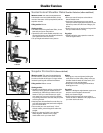
23
Muscles worked: The entire chest muscle
(pectoralis major) is emphasized. It also involves
the front shoulder muscles (anterior deltoid, a
portion of the middle deltoid) and the triceps,
which are located on the back of the upper arms.
Pulley position: Wide or narrow (Wide offers a
greater challenge throughout the entire range
on specific movements, especially at the top of
these movements. This can make these exercises
even more effective. However, when both pulley
positions are listed as options, do not attempt to
use the same weight for each position).
Starting position:
• Seated in the incline position, reach straight
behind your body, grasp the handles with an
overhand grip and bend your elbows until your
hands are near your chest. Rotate upper arms
away from your torso so your elbows point
outward and your palms face forward.
• Make sure cables travel underneath your arms,
not over your arms.
• Keeping knees bent and feet flat on the floor, lay
your head back against the bench and straighten
your arms to the front.
• From this position, lower your arms 10-15
degrees (cables touching the bottom of your
arms/shoulders) below the regular bench press
position (cables lying along the back of your arm
and center of the shoulders).
• Be sure your arms are directly in-line with the
cables, palms facing forward and wrists straight.
If the cables are "below" the arms, the arms are
too low.
• Raise your chest and slightly "pinch" your
shoulder blades together. Maintain a very slight,
comfortable arch in your lower back.
Motion:
• Slowly move your elbows outward,
simultaneously bending your arms so that your
forearms remain parallel to each other and the
hands remain over the elbows throughout the
movement. From the side view it should appear
as if the forearms are in line with the cables at
all times.
• Stop when your upper arms are approximately
straight out to the sides (your elbows will be level
with your shoulders or slightly below).
• Then, slowly press forward, moving the hands
toward the center, and return to the starting
position with arms straight to the front at
shoulder width and in line with the cables. Keep
your chest muscles tightened during the entire
motion.
Optional motions:
• Bilateral movement - both arms pressing forward
at the same time.
• Unilateral movement – performing all reps with
one arm before moving to the next.
• Alternating – performing one rep on one side and
then the next rep on the other side.
• Simultaneously alternating – both arms moving,
although in opposite directions (one pressing
while the other is returning).
Key points:
• The upper arms will be 60-90 degrees from
the sides of your torso at the bottom of the
movement and slightly less than 90 degrees from
the front of your torso at the top.
• Limit the range of motion so your elbows travel
only slightly behind your shoulders —
if at all.
Chest Exercises
Decline Bench Press Shoulder Horizontal Adduction (with elbow extension)
Muscles worked: This exercise involves the entire
chest muscle, the front shoulder muscles (anterior
deltoid, a portion of the middle deltoid) and the
triceps, located on the back of the upper arms.
The goal however, is not any specific muscle
group. It is to be used with very light resistance
for an endurance activity.
Pulley position: Narrow only.
Starting position:
• With the bench flat and locked in the back
position against the lat tower, sit facing away
from the Power Rods
®
.
• Reach straight behind your body, grasp the
handles with an overhand grip so that the cable
will lay between your arm and your torso.
• Bend your elbows until your hands are level with
your waistline and your palms are facing your
torso.
• Maintain erect posture.
Motion:
• Using a moderate speed and light weight, rotate
your trunk and press one arm forward to full
extension, allowing the shoulder blade to move
forward at the end of the punch.
• Return that arm to the starting position — under
control — and repeat with the
other arm.
• As an alternative to punching straight forward
you may also punch upward at an angle in line
with the cable.
Optional motions:
• Bilateral movement – both arms pressing
forward at the same time.
• Unilateral movement – performing all reps with
one arm before moving to the next.
• Alternating – performing one rep on one side and
then the next rep on the other side.
• Simultaneously alternating – both arms moving,
although in opposite directions (one pressing
while the other is returning).
Key points:
• Maintain an upright, erect posture as your trunk
twists/rotates with the punch.
• It is important to note that "sport specific"
movements will not necessarily improve the skill
associated with a sport.
Resisted Punch Shoulder Flexion, Elbow Extension and Scapular Protraction
FINISH
START
FINISH
START


















